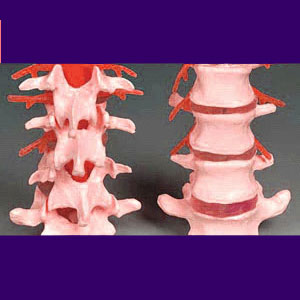
Osteoporosis pain might actually be a theoretically beneficial addition to the effects of this extremely common bone disorder. If the condition actually did cause pain directly, then more people would be aware of it, prevent it or seek treatment for it. Unfortunately, the osteoporosis condition is not inherently painful at all and is often discovered when it is too late to do anything to reverse it.
It is crucial to understand that although low bone density and increased bone porosity are not painful unto themselves, the consequences of osteoporosis can certainly cause anatomical injury and subsequent pain from a variety of different conditions including advanced osteoarthritis and vertebral fracture.
Osteoporosis-Related Pain from Fractures
Many elderly people discover they have osteoporosis when they fracture a bone in a fall or other traumatic occurrence. Common sites for painful fractures include the wrist, the hip, the foot and the arm. Osteoporosis makes the bones in these, and other bodily areas, brittle and easily broken.
Vertebral compression fractures are also very common in the spinal column. These fractures can occur from a fall, trauma or simply due to the weight of the body. Compression fractures are rarely severely painful and many of them go completely unnoticed by the patient and their doctor. Compression fractures can be serious, regardless of whether or not they are symptomatic. Multiple or severe compression fractures can lead to several forms of degenerative back pain or even spinal instability. Elderly people are always advised to evaluate their bone density regularly with the help of their doctors and should also seek to avoid any activity which may cause or contribute to fractures.
Preventing Osteoporosis Pain
Even though osteoporosis is not painful in itself, the resulting effects certainly can be. A broken bone occurring in an elderly patient can lead to disability and far more serious health conditions. Elderly patients who are confined to bed or to a limited lifestyle, while nursing a fracture, are more likely to develop other serious and possibly fatal health problems. Pneumonia is a particular risk for weakened and bed-ridden patients and is a leading cause of death in older patients.
Likewise, the osteoarthritic processes will take advantage of weakened bones, often creating the ideal circumstances for central spinal stenosis or neuroforaminal stenosis to take place. These diagnoses can cause both pain and serious neurological effects in many instances.
Osteoporosis Pain Analysis
Osteoporosis is a condition that is mostly preventable. Learn the facts about this condition while you are still young enough to stop it from rearing its ugly head in your advanced years.
If you already have been diagnosed with osteoporosis, make sure to be particularly careful with your body and get regular check ups and bone density tests. Follow your recommended treatment to the letter, to keep yourself healthy and injury free.
Most of all, follow a balanced diet and be sure to exercise regularly, since it is never too late to take good care of your bones. Talk to your doctor to learn more about osteoporosis care.




